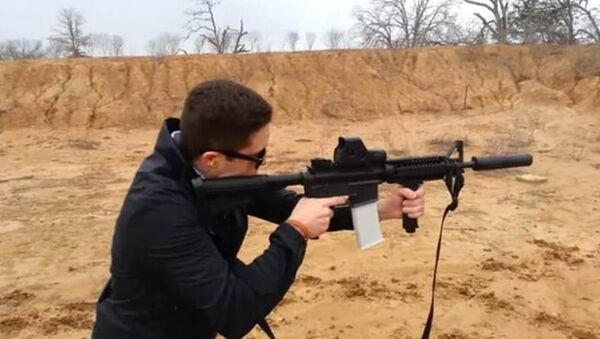WASHINGTON, March 19 (RIA Novosti) - A Texas firm aiming to manufacture guns using a 3-D printer – and publicly share the online files with anyone who wants to do the same – has been issued a license to build and sell 3-D weapons from the US Bureau of Alcohol, Tobacco and Firearms (ATF).
“The whole idea is a printable firearm that can be downloaded online for free,” said Cody Wilson, a law school student and founder of Defense Distributed, the newly-licensed Austin, Texas company that also promotes 3-D gun making, in an interview with RIA Novosti.
“One day it will be possible, when pretty much everybody has a 3-D printer, for anyone to download a free file and print out a gun, anywhere in the world. And your government would have nothing to say about it,” he said.
"Look who has a license to manufacture firearms," declared a posting on the Facebook page for Defense Distributed over the weekend, with an apparent photo of the new license.
Wilson said he’s less interested in making 3-D printed guns he can sell than he is in helping other people to make their own. It’s too hard for the average person to wade through the trial-and-error process to create a gun that will work, and the laws that govern that process are unclear, he said.
The license allows him to legally do the work, test the guns to be sure they function, and put the instructions and demo videos online, where they can be downloaded for free.
Defense Distributed has three company goals for a project it calls “the wiki weapon:” develop a fully printable firearm; adapt the design for use with cheaper 3-D printers; and facilitate a “creative commons” arena for the public distribution of 3-D printable weapons files.
The company has been issued a license to manufacture firearms, but not automatic firearms, ATF spokeswoman Donna Sellers told NBC News. She said the bureau “collaborated with law enforcement and the firearms industry” before granting the license.
“There’s no background check, no license registration. Not only can you have the file but you can make the gun right in the comfort of your own home and no one can say anything about it,” said Wilson.
Defense Distributed has an “in-your-face” style and a willingness to take on the gun control lobby.
Among its creations are the “Feinstein,” an assault rifle magazine made with 3-D printing technology, named after US Sen. Dianne Feinstein, author of a bill to ban assault weapons that was shot down by Senate Democrats on Tuesday.
There’s also the “Cuomo,” a 3-D magazine that holds 30 bullets, named for New York Gov. Andrew Cuomo, who signed the toughest gun control law in the nation in January, which limits gun magazines to seven rounds.
“How’s that national conversation going?” asks Wilson in an online video in which he fires a weapon that uses a printed magazine clip.
It’s an apparent reference to the call for a national conversation on the topic of gun control, made by President Barack Obama in the wake of several mass shootings in the United States.
“I think the national conversation is a joke. We should deal with people if they violate the law, but not until afterwards, on the back end,” rather than by tackling the problem in a way that limits freedoms for everyone, Wilson said.
3-D printing is a relatively new technology that allows three-dimensional, solid objects to be replicated using layers of material – usually plastic – that are molded into shape according to a digital file.
It has primarily been used for replicating jewelry, toys, artwork, even human body parts. But the use of 3-D printing to make weapons has been both controversial and challenging. Heat tends to melt the plastic, and the printed parts don’t readily withstand the pressure of firing a bullet.
Wilson and several others have made some 3-D parts for guns, but so far, not a whole gun. He has posted free online instructions for the printed parts his firm has made and tested.
US Rep. Steve Israel believes it is just a matter of time before technology finds a solution. He’s introduced legislation to extend a ban on plastic guns, set to expire this year.
“Congress passed a law banning plastic guns for two decades, when they were just a movie fantasy. With the advent of 3-D printers these guns are suddenly a real possibility… We should act now to give law enforcement authorities the power to stop the development of these weapons before they are as easy to come by as a Google search,” Israel said in a statement.
In the meantime, Defense Distributed is moving forward with its plans.
“How do governments behave if they must one day operate on the assumption that any and every citizen has near instant access to a firearm through the Internet?” the Defense Distributed website asks, adding, “Let’s find out.”
“We’ve been sitting on our hands for months,” Wilson said. “We’re ready to go.”




